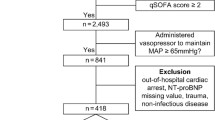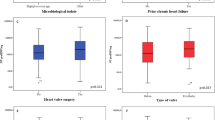Abstract
Introduction
N-terminal pro brain natriuretic peptide (NT-proBNP) is a cardiac biomarker that has recently shown to be of diagnostic value in a diagnosis of decompensated heart failure, acute coronary syndromes and other conditions resulting in myocardial stretch. We sought to study whether sepsis-induced myocardial dilation would result in an elevation of NT-proBNP.
Method
Serum NT-proBNP measurements were made in six consecutive patients with septic shock within 6 hours of admission to the intensive care unit.
Results
Markedly elevated levels of NT-proBNP were found in all six patients.
Conclusions
NT-proBNP levels can be markedly elevated in critically ill patients presenting with septic shock. An elevated NT-proBNP level in a critically ill patient is not specific for decompensated heart failure.
Similar content being viewed by others
Introduction
Brain natriuretic peptide (BNP) is a hormone synthesized in the ventricular myocardium. The stimulus for its release is increased ventricular wall tension. Gene expression is the main regulator of BNP secretion, and can increase very rapidly in response to an appropriate stimulus. It is produced in the prohormone form (proBNP), which before secretion by cardiomyocytes is split into the inactive 76-residue N-terminal fragment (NT-proBNP) and the biologically active 32-residue C-terminal fragment (BNP) [1].
BNP has been shown to be a useful cardiac biomarker for the identification of patients with suspected heart failure [2]. Elevated serum levels have also been described in left ventricular systolic and diastolic dysfunction and right ventricular pressure overload states such as pulmonary embolism, cor pulmonale and primary pulmonary hypertension [3].
In a recent study by Witthaut and colleagues [4], both atrial natriuretic peptide (ANP) and BNP were found to be significantly elevated in patients with septic shock in comparison with controls.
More recently, Charpentier and colleagues [5] made a similar observation for BNP in patients with severe sepsis or septic shock who had echocardiographic evidence of systolic myocardial dysfunction.
A similar elevation of NT-proBNP in septic shock has, to our knowledge, not been described before. We sought to study NT-proBNP because it had been found in the context of heart failure to increase in concentration more strikingly and to have better sensitivity and positive predictive value than BNP [6].
Methods
Patient population
We describe six patients admitted to the Medical Intensive Care Unit (ICU) in our institution in July 2003 with septic shock. None had a prior history of hypertension. Septic shock was defined in accordance with the criteria of the consensus conference of the American College of Chest Physicians and Society of Critical Care Medicine [7]. Severity of disease was quantified by the Acute Physiology and Chronic Health Evaluation II (APACHE II) score [8].
Blood sampling and determination of NT-proBNP levels
All patients had blood samples taken for serum NT-proBNP measurement within 6 hours of admission. Serum NT-proBNP was determined with a sandwich immunoassay on an Elecsys 2010 (Roche Diagnostics, Mannheim, Germany). The analytical range extends from 20 ng l-1 to 35 μg l-1.
Ethics
Approval was obtained from our hospital's Institutional Review Board.
Results
The clinical details of the six patients are summarized in Table 1. All were in septic shock requiring vasopressors. None had pre-existing hypertension, ischemic heart disease or cor pulmonale.
The initial hemodynamic profile of patient 1 is described in further detail. After fluid resuscitation comprising 2.5 litres of colloids, the patient required intravenous dopamine (15 μg kg-1 min-1 to maintain a mean blood pressure of 70 mmHg. The cardiac index was 3.06 l min-1 m-2. Intrathoracic blood volume index (ITBVI) was 816 ml m-2 (normal range 850–1000 ml m-2) and stroke volume index was 25 ml m-2 (normal range 40–60 ml m-2). These hemodynamic data were measured with the PiCCO® (Pulsion Medical Systems, Munich, Germany). The data demonstrate no obvious excess of intravascular volume.
Discussion
Cardiac dysfunction is often present in patients with septic shock. In a recent study by Charpentier and colleagues [5], systolic myocardial dysfunction (as defined by a fractional area contraction of less than 50% on echocardiography) was present in 44% of a cohort of patients with severe sepsis or septic shock, on the second day of their stay in the ICU. It is now evident that myocardial depression has a clear role in septic shock. Septic myocardial depression is characterized by reversible biventricular dilation, decreased systolic contractile function, and decreased response to both resuscitation with fluids and stimulation with catecholamines [9]. This myocardial depression occurs in the presence of an overall hyperdynamic circulation. This phenomenon is linked to the presence of a circulating myocardial depressant factor, which is probably due to tumour necrosis factor-α and interleukin-1β acting in synergy. These effects are mediated by mechanisms that include the generation of nitric oxide and cyclic GMP [10].
Our results show clearly that NT-proBNP levels can be markedly elevated in critically ill patients presenting with septic shock. To our knowledge, our study is the first to describe this observation. We postulate that this marked elevation of NT-proBNP in our patients is a reflection of sepsis-induced ventricular dilation. The important diagnostic implication of our results is that an elevated NT-proBNP level in a critically ill patient is not specific for decompensated heart failure.
The magnitude of elevation of NT-proBNP seen in our patients was much greater than the twofold increase in BNP and fourfold increase in ANP described by Witthaut and colleagues [4]. This might be due to the longer half-life of NT-proBNP. NT-proBNP might therefore be a more sensitive marker of septic cardiomyopathy.
It remains to be seen whether the magnitude or trend of NT-proBNP elevation in septic shock holds any prognostic value. Further studies should be done to address this issue. What is also unanswered at this time is which of the cardiac biomarkers – BNP, NT-proBNP or ANP – is the best biological marker of myocardial dysfunction in patients with severe sepsis or septic shock.
Key messages
-
NT-proBNP elevations are seen in severe sepsis.
-
There are non-heart-failure causes of NT-proBNP elevations in the ICU.
Abbreviations
- ANP:
-
atrial natriuretic peptide
- BNP:
-
brain natriuretic peptide
- ICU:
-
intensive care unit
- NT-proBNP:
-
N-terminal pro brain natriuretic peptide.
References
Clerorico A, Iervasi G, Mariani G: Pathophysiologic relevance of measuring the plasma levels of cardiac natriuretic peptide hormones in humans. Horm Metab Res 1999, 31: 487-498.
Maisel A, Krishnaswamy P, Nowak R: Rapid measurement of B-type natriuretic peptide in the emergency diagnosis of heart failure. N Engl J Med 2002, 347: 161-167. 10.1056/NEJMoa020233
de Lemos J, McGuire D, Drazner M: B-type natriuretic peptide in cardiovascular disease. Lancet 2003, 362: 316-322. 10.1016/S0140-6736(03)13976-1
Witthaut R, Busch C, Fraunberger P, Walli A, Seidel D, Piltz G, Stuttmann R, Speichermann N, Verner L, Werdan K: Plasma atrial natriuretic peptide and brain natriuretic peptide are increased in septic shock: impact of interleukin-6 and sepsis-associated left ventricular dusfunction. Intensive Care Med 2003, 29: 1696-1702. 10.1007/s00134-003-1910-0
Charpentier J, Luyt C, Fulla Y, Vinsonneau C, Cariou A, Grabar S, Dhainaut JF, Mira JP, Chiche JD: Brain natriuretic peptide: a marker of myocardial dysfunction and prognosis during severe sepsis. Crit Care Med 2004, 32: 660-665. 10.1097/01.CCM.0000114827.93410.D8
Lainchbury J, Campell E, Frampton C, Yandle T, Nicholls G, Richards M: Brain natriuretic peptide and N-terminal brain natriuretic peptide in the diagnosis of heart failure in patients with acute shortness of breath. J Am Coll Cardiol 2003, 42: 728-735. 10.1016/S0735-1097(03)00787-3
American College of Chest Physicians/Society of Critical Care Medicine Consensus Conference Committee: Definitions of sepsis and multiple organ failure and guidelines for the use of innovative therapies in sepsis. Crit Care Med 1992, 20: 864-874.
Knaus WA, Draper EA, Wagner DP, Zimmermann JE: APACHE II: a severity of disease classification system. Crit Care Med 1985, 13: 818-829.
Parker SM, Sheilhamer JH, Natanson C, Alling DW, Parrillo JE: Serial cadiovascular variables in surviviors and nonsurvivors of human septic shock: heart rate as an early predictor of prognosis. Crit Care Med 1987, 19: 1520-1525.
Kumar A, Thota V, Dee L, Olson J, Uretz E, Parrillo JE: Tumour necrosis factor-alpha and interleukin-1 beta are responsible for depression of in vitro myocardial cell contractility induced by serum from humans with septic shock. J Exp Med 1996, 183: 949-958.
Acknowledgments
The authors would like to thank the Medical ICU residents and nurses for their assistance in this project.
Author information
Authors and Affiliations
Corresponding author
Additional information
Authors' contributions
Both authors contributed to the study design, implementation of the study and the final version of the report. GC collected and interpreted the data and wrote the report.
Competing interests
None declared.
Rights and permissions
This article is published under an open access license. Please check the 'Copyright Information' section either on this page or in the PDF for details of this license and what re-use is permitted. If your intended use exceeds what is permitted by the license or if you are unable to locate the licence and re-use information, please contact the Rights and Permissions team.
About this article
Cite this article
Chua, G., Kang-Hoe, L. Marked elevations in N-terminal brain natriuretic peptide levels in septic shock. Crit Care 8, R248 (2004). https://doi.org/10.1186/cc2889
Received:
Accepted:
Published:
DOI: https://doi.org/10.1186/cc2889




